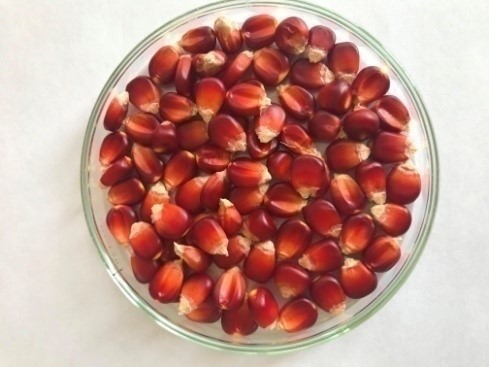THE STUDY OF ANTHOCYANINS OF CORN WITH DARK GRAIN
UDC 633.15:543.641
Abstract
In corn grains, anthocyanins pigments accumulate – belonging to the class of flavanoids, products of the secondary metabolism of plants and which are low molecular weight antioxidants. Numerous epidemiological studies have shown that the use of foods rich in anthocyanins leads to a significant reduction in diabetes, obesity, cardiovascular and oncological diseases. Compared to an equal amount of vegetables and fruits containing anthocyanins, more of them are present in the grain in bound form. Participating in the metabolism in the lower parts of the gastrointestinal tract, they have a beneficial effect on maintaining health. To analyze the total content and determine the composition of anthocyanins in grains of 21 samples of corn from the collection of the National Gene Bank of Azerbaijan, in order to identify promising samples in breeding to increase the content of anthocyanins, we used the method of high-performance liquid chromatography with reverse phase (HPLC) with spectrophotometric and mass spectrometric detection. The grains of the test samples identified mainly cyanidin-3-glucoside and pelargonidin-3-glucoside, as well as the isomeric products of their mono- and diacylation with malonic acid. Pelargonidin-3-glucoside derivatives prevailed in the grain extracts of some of the samples studied. Corn samples were selected as starting material for further breeding work to create local forms of corn with improved nutritional and therapeutic properties.
Downloads
Metrics
References
Abdel-AalEl.-S.M., Akhtar H., Zaheer K., Ali R. Nutrients, 2013, vol. 5(4), pp. 1169–1185. DOI: 10.3390/nu5041169.
Acuña E.D., Delgado-Cotrina L., Rumiche F.A., Tay L.Y. Scientifica, 2016, vol. 2016, article 2970548. DOI: 10.1155/2016/2970548.
Voylokov A.V., Lykholay A.N., Smirnov V.G. Vavilovskiy zhurnal genetiki i selektsii, 2014, vol. 18, no. 4/1, pp. 776–783. (in Russ.).
Solovchenko A.Ye., Chivkunova O.B. Fiziologiya rasteniy, 2011, vol. 58, no. 4, pp. 582–589. (in Russ.).
Kong J.M., Chia L.S., Goh N.K., ChiaT.F, Brouillard R. Phytochemistry, 2003, vol. 64, pp. 923–933. DOI: 10.1016/s0031-9422(03)00438-2.
Tret'yakov M.Yu., Khoroshilov S.A., Sidorov A.N., Chulkov A.N., Deyneka V.I., Deyneka L.A. Dostizheniya nauki i tekhniki APK, 2012, no. 9, pp. 30–32. (in Russ.).
Salinas-Moreno Y., Salas-Sánchez G., Rubio-Hernández D., Ramos-Lobato N. J. Chrom. Sci., 2005, vol. 43, pp. 483–487. DOI: 10.1093/chromsci/43.9.483-487.
Gould K., Davies K., Winefield C. Anthocyanins, Biosynthesis, Functions, and Applications, Springer Science & Busi-ness Media, LLC, 2009, 332p.
Tsuda T. Mol. Nutr. Food. Res., 2012, no. 56, pp. 159–170.
Khlestkina E.K. Cereal Res. Commun., 2013, no. 41, pp. 185–198. DOI: 10.1556/CRC.2013.0004.
Petroni K., Pilu R., Tonelli C. Planta, 2014, vol. 240, no. 5, pp. 901–911. DOI: 10.1007/s00425-014-2131-1.
Amini A.M., Muzs K., Spencer Jeremy P.E., Yaqoob P. Nutr. Res., 2017, vol. 46, pp. 88–95. DOI: 10.1016/j.nutres.2017.09.006.
Khoo H.E., Azlan A., Tang S.T., Lim S.M. Food Nutr Res., 2017, vol. 61, no. 1, article 1361779, DOI: 10.1080/16546628.2017.1361779.
Urias-Lugo D.A., Heredia J.B., Serna-Saldivar S.O., Muy-Rangel M.D., Valdez-Torres J.B. CyTA-Journal of Food, 2015, vol. 13, no. 3, pp. 336–339.
Polonskiy V.I., Loskutov I.G., Sumina A.V. Vavilovskiy zhurnal genetiki i selektsii, 2018, vol. 22(3), pp. 343–352. DOI: 10.18699/VJ18.370. (in Russ.).
Salinas-Moreno Y., García-Salinas C., Coutiño Estrada B, Vidal Martínez V.A. Rev. Fitotec. Mex., 2013, vol. 36, no. 3-A, pp. 285–294.
Urias-Peraldí M., Gutiérrez-Uribe J.A., Preciado-Ortiz R.E., Cruz-Morales A.S., Serna-Saldívar S.O., García-Lara S. Field Crops Research, 2013, vol. 141, pp. 69–76. DOI: 10.1016/j.fcr.2012.11.008.
Valiyeva L.S., Rahimova G.K., Nabiyeva N.A. Proceedings of the Fifth International Scientific Conference PlantGen2019 (June 24-29, Novosibirsk, Russia), Novosibirsk, 2019, pp. 39–41. DOI 10.18699/ICG-PlantGen2019-10
Deyneka V.I., Sidorov A.N., Deyneka L.A. Zhurnal analiticheskoy khimii, 2016, vol. 71, no. 11, pp. 1203–1208. DOI: 10.7868/S0044450216110049. (in Russ.).
Deyneka V.I., Sorocopudov V.N., Deyneka L.A., Shaposhnik E.I., BurmenkoY.V., Litvinova L.S. Nauchnyye vedomosti BelGu. Seriya Meditsina. Farmatsiya, 2013, vol. 23, no. 18(161), pp. 225–228.
Douglas D.K., Baker D.C., Gakh E., Redus M. Food Tech., 1997, no. 15, pp. 69–71.
Nakayama T., Suzuki H., Nishino T. J. Mol. Catal. B Enzym., 2003, no. 23, pp. 117–132.
Woodward G.M., Needs P.W., Kay C.D. Mol. Nutr. Food Res., 2011, no. 55, pp. 378–386.

Copyright (c) 2020 chemistry of plant raw material

This work is licensed under a Creative Commons Attribution 4.0 International License.

This work is licensed under a Creative Commons Attribution 4.0 International License.
The authors, which are published in this journal, agree to the following conditions:
1. Authors retain the copyright to the work and transfer to the journal the right of the first publication along with the work, at the same time licensing it under the terms of the Creative Commons Attribution License, which allows others to distribute this work with the obligatory indication of the authorship of this work and a link to the original publication in this journal .
2. The authors retain the right to enter into separate, additional contractual agreements for the non-exclusive distribution of the version of the work published by this journal (for example, to place it in the university depository or to publish it in a book), with reference to the original publication in this journal.
3. Authors are allowed to post their work on the Internet (for example, in a university repository or on their personal website) before and during the review process of this journal, as this may lead to a productive discussion, as well as more links to this published work.











